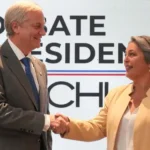
The Labour Party has won a historic landslide victory in the UK general election, returning to government after 14 years in opposition. Party leader Sir Keir Starmer, who will take office as prime minister on Friday (5), told supporters in London that “change starts here… You voted. Now it’s our turn to deliver.”
What is the Labour Party majority?
As of 6.50am on Friday, Labour had won 402 seats and is on course to secure a majority of around 180 seats in the House of Commons – similar to the 179-seat majority won by Tony Blair in the 1997 election.
The Conservative Party became the official opposition, winning 109 seats so far, its worst performance in a general election. The centrist Liberal Democrats won 67 seats, while the populist Reform UK party has four MPs, including Brexit campaigner Nigel Farage. The Scottish National Party, traditionally dominant in Scotland, won eight seats, down 38 from the last election, and the Green Party won four seats.
Which parliamentarians lost their seats?
Notable Conservatives who will not return to parliament include former Prime Minister Liz Truss, Commons Leader Penny Mordaunt and Defence Secretary Grant Shapps. Truss, who has represented South West Norfolk since 2010, was outvoted by Labour by around 600 votes. Forced to leave Downing Street after just 49 days in 2022, she is the first former prime minister to lose a general election in almost 90 years. Mordaunt, who ran for the party leadership in 2022 and was considered a future candidate, failed to be re-elected as MP for Portsmouth North. Shapps, MP for Welwyn Hatfield since 2005, was also defeated by Labour. Other Conservatives who lost their seats included Education Secretary Gillian Keegan, Justice Secretary Alex Chalk, Transport Secretary Mark Harper, Culture Secretary Lucy Frazer, as well as former ministers Thérèse Coffey and Sir Jacob Rees-Mogg.
Some prominent Labour figures were also defeated. Treasurer-General Jonathan Ashworth lost to a pro-Palestinian independent in Leicester South, while Culture Secretary Thangam Debbonaire was defeated by the Green Party in Bristol Central.
How did the election result reshape the UK’s political map?
The Conservatives lost several “blue wall” seats in the south of England to the Liberal Democrats, who had focused heavily on that region during the six-week campaign. Labour regained parts of the “red wall” in the north of England, traditionally working-class areas that had been lost to the Conservatives in the 2019 election. Starmer’s party also regained large parts of Scotland, where it had previously been the main political force before being overtaken by the SNP.
What was the turnout?
Some 59% of eligible voters in the UK turned out to vote, according to provisional figures published by the PA news agency. That is a near-record low, underlining the huge challenge Starmer faces in restoring voter confidence in the political system. In the 2019 election, turnout was 67.3%, down from 68.8% in 2017, according to data from the House of Commons library. This general election was the first in which voters were required to show ID to cast a ballot, under a change in the law approved by the government in April 2022.
What happens next?
Rishi Sunak, who said he had called Starmer to congratulate him, is expected to resign as leader of the Conservative Party, triggering a race to replace him. Sunak is expected to tender his resignation as prime minister in an audience with King Charles at Buckingham Palace on Friday. The king will then receive Starmer, who will ask for permission to form a new government. After that, Starmer will arrive at Downing Street and deliver an address to the nation before meeting with the Number 10 team. He is expected to announce his cabinet on Friday afternoon.
With information from News Agencies
Source: https://www.ocafezinho.com/2024/07/05/partido-trabalhista-garante-vitoria-esmagadora-no-reino-unido/

